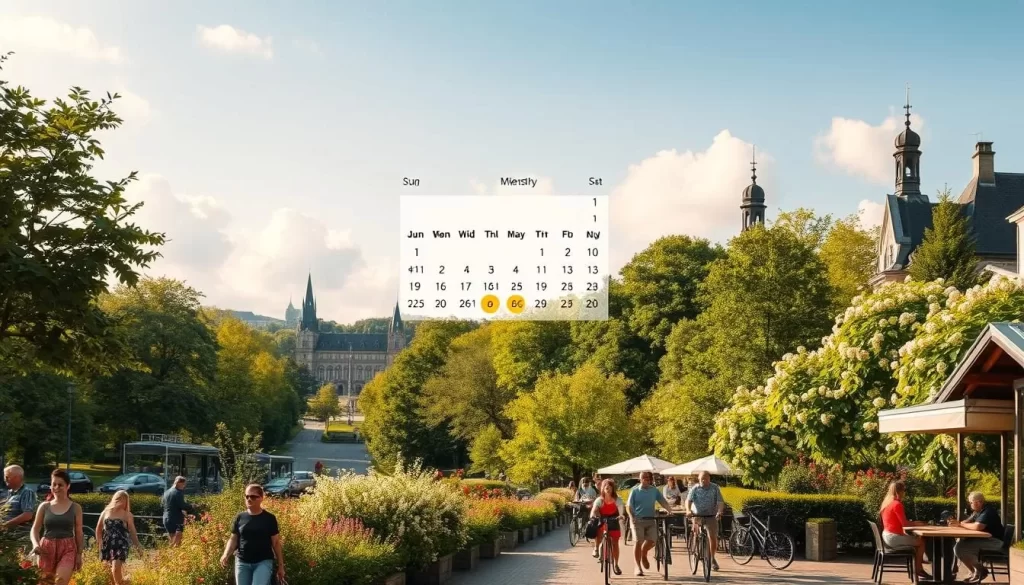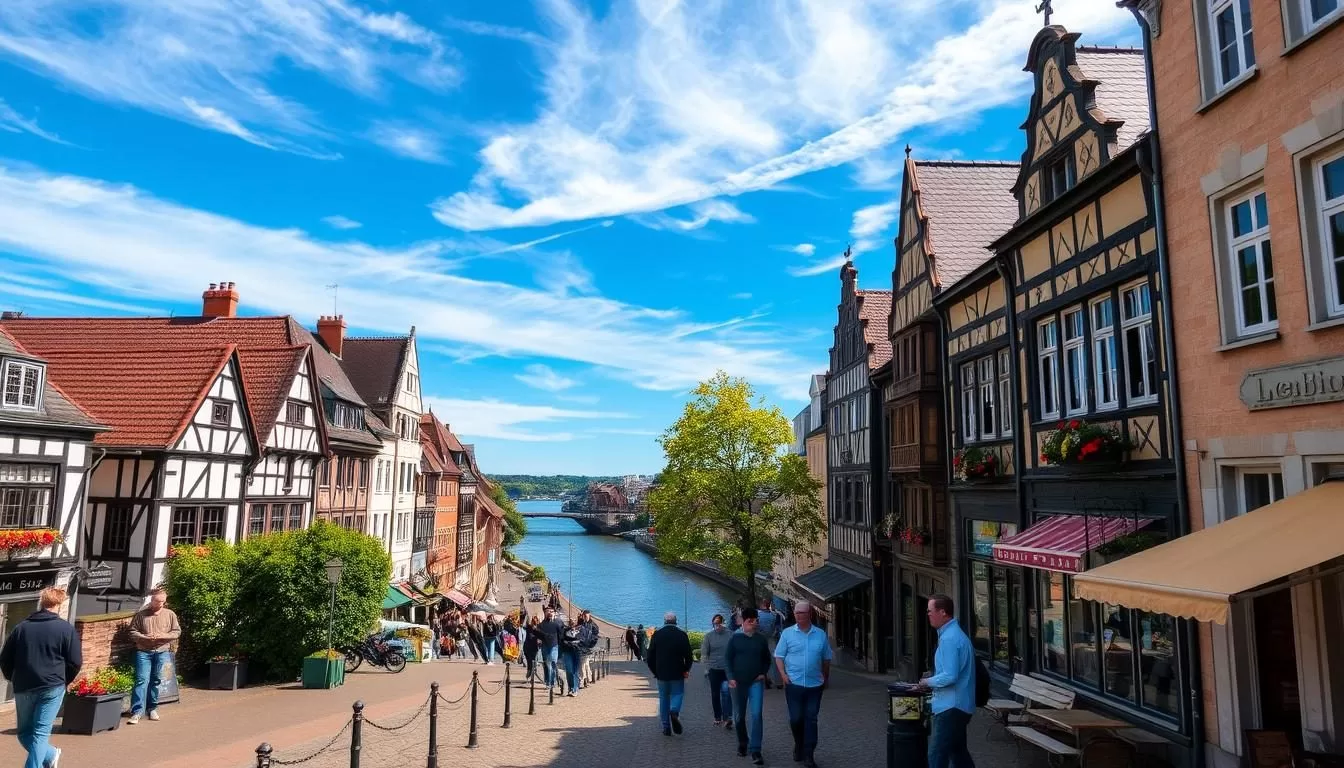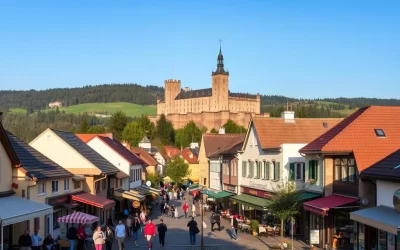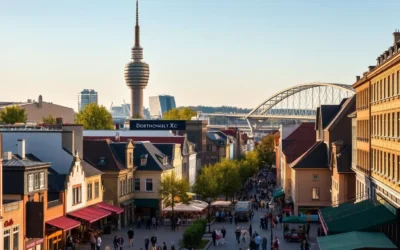✓ Accommodations✓ Flights✓ Rental Cars✓ Tours & Activities
Choosing the right month for your trip can make all the difference in your travel experience. Whether you’re looking for sunny skies, cultural events, or fewer crowds, timing is key. This guide will help you navigate the seasons and pick the best time to explore this vibrant destination.
From warm summers perfect for outdoor adventures to chilly winters with festive charm, each season offers something unique. You’ll also discover tips on local festivals, weather patterns, and how to make the most of your visit. Let’s dive into what makes every month special and how you can plan your ultimate getaway.
Introduction: Why Timing is Key for Your German Adventure
Timing your visit can transform your travel experience. Weather plays a big role in how you enjoy your trip. Sunny days are perfect for outdoor activities, while rain might push you indoors. Planning around the seasons ensures you get the most out of your adventure.
Aligning your trip with local events can also make it unforgettable. From spring festivals to winter markets, there’s always something happening. Visiting during these times lets you dive into the culture and create lasting memories.
Traveling during less crowded seasons has its perks. You’ll avoid long lines and enjoy a more relaxed pace. Plus, off-peak periods often come with better deals on flights and accommodations. This makes it easier to stick to your budget while still having a great time.
Understanding seasonal trends is key to planning your trip. For example, spring brings blooming gardens and mild weather. Winter, on the other hand, offers festive markets and cozy vibes. Knowing what to expect helps you pack and plan accordingly.
| Season | Weather | Highlights |
|---|---|---|
| Spring | Mild, blooming | Festivals, gardens |
| Summer | Warm, sunny | Outdoor events, biergartens |
| Fall | Crisp, colorful | Harvest festivals, scenic walks |
| Winter | Cold, festive | Christmas markets, cozy vibes |
By choosing the right time to visit, you can tailor your trip to your preferences. Whether you love sunny days or festive nights, there’s a perfect season for you. Start planning today to make your German adventure unforgettable.
Understanding Düsseldorf’s Climate and Seasonal Trends
Weather patterns play a significant role in shaping your travel experience. Knowing what to expect can help you pack smarter and plan better. This section dives into the city’s climate, focusing on temperature, rainfall, and daylight hours.

Seasonal Weather Patterns and Temperature Variations
The city experiences a temperate climate with distinct seasons. Summers are warm, with average highs around 75°F. Winters, on the other hand, can be chilly, with lows dipping to 42°F. Spring and fall offer mild temperatures, making them ideal for outdoor activities.
These variations mean you’ll need to adjust your wardrobe depending on when you visit. Summer calls for light clothing, while winter requires layers to stay cozy. Understanding these patterns ensures you’re always comfortable, no matter the season.
Rainfall, Cloud Cover, and Daylight Hours
Rainfall is fairly consistent throughout the year, with slightly higher amounts in summer. On average, the city sees about 2 inches of rain per month. Cloud cover varies, with winters being cloudier and summers offering more sunshine.
Daylight hours also change significantly. In summer, you’ll enjoy up to 16 hours of daylight, perfect for exploring. Winter days are shorter, with only about 8 hours of sunlight. Planning around these factors can help you maximize your time outdoors.
These climate details not only influence your packing but also impact local events and activities. Festivals and outdoor markets often align with favorable weather, so timing your visit right can enhance your experience.
Düsseldorf, Germany: Best Months for a Weather-Savvy Trip
The right timing can turn your trip into an unforgettable adventure. Choosing the ideal month ensures you enjoy pleasant weather, fewer crowds, and a deeper cultural experience. Let’s explore why certain months stand out as the best time to visit.
May is a standout month for travelers. With mild temperatures averaging around 60°F, it’s perfect for outdoor activities like strolling through parks or exploring local markets. The city’s gardens are in full bloom, creating a picturesque backdrop for your adventures.
Shoulder seasons, like late spring and early fall, offer a balance of pleasant weather and fewer tourists. You’ll avoid the summer crowds while still enjoying warm days and cool evenings. These months also come with lower travel costs, making them a budget-friendly option.
Summer, from June to September, is ideal for outdoor excitement. Average highs reach 75°F, perfect for festivals, biergartens, and river cruises. However, this is also the busiest time, so plan ahead to secure accommodations and tickets.
As the season transitions from summer to winter, temperatures drop, and the city transforms into a festive wonderland. December’s Christmas markets are a must-see, offering cozy vibes and unique shopping experiences. Winter lows hover around 42°F, so pack warm layers.
Here’s a quick comparison of the benefits:
- Spring: Mild weather, blooming gardens, fewer crowds.
- Summer: Warm temperatures, lively events, longer days.
- Fall: Crisp air, colorful scenery, harvest festivals.
- Winter: Festive markets, cozy atmosphere, lower costs.
By selecting the right month, you’ll enhance both your comfort and cultural immersion. Whether you prefer sunny days or festive nights, there’s a perfect season for your travel style. Start planning today to make the most of your trip.
Exploring Seasonal Activities and Festivals in Düsseldorf
Dive into a year-round calendar of vibrant events and traditions. Each season brings unique celebrations that showcase the city’s rich culture. From lively summer festivals to enchanting winter markets, there’s always something to enjoy.
Summer Festivals, Biergartens, and Outdoor Concerts
Summer is a time of excitement and energy. The city comes alive with music festivals, outdoor concerts, and traditional biergartens. One of the highlights is the Rheinkirmes, a massive fun fair along the Rhine River. It’s a perfect spot to enjoy thrilling rides, local food, and live entertainment.
Biergartens are a must-visit during this season. These open-air venues offer a relaxed atmosphere to savor local brews and hearty meals. Pair your drink with pretzels or sausages for an authentic experience.

Outdoor concerts are another summer staple. From jazz to rock, there’s a genre for every music lover. These events often take place in parks or by the river, creating a magical backdrop for unforgettable evenings.
Winter Markets, Christmas Celebrations, and Cultural Events
Winter transforms the city into a festive wonderland. Christmas markets are the heart of the season, offering cozy vibes and unique shopping experiences. Stroll through stalls filled with handmade crafts, ornaments, and delicious treats like gingerbread and mulled wine.
These markets have a rich history, dating back centuries. They’re not just about shopping but also about celebrating traditions. Enjoy live music, carolers, and the warm glow of twinkling lights.
Cultural events also take center stage during winter. From theater performances to art exhibitions, there’s plenty to explore. These activities provide a deeper connection to the city’s heritage and creativity.
| Season | Highlight | Tips |
|---|---|---|
| Summer | Rheinkirmes, biergartens, outdoor concerts | Visit midweek to avoid crowds |
| Winter | Christmas markets, cultural events | Arrive early for a peaceful shopping experience |
Whether you’re drawn to the lively beats of summer or the cozy charm of winter, these events enhance your travel experience. Plan your visit around these celebrations to immerse yourself in the city’s vibrant culture.
Navigating Crowds and Budget Considerations
Traveling off-peak offers a unique blend of savings and serenity. By avoiding peak seasons, you can enjoy a more relaxed experience while keeping your budget in check. This section provides practical tips to help you make the most of your trip without breaking the bank.
Traveling Off-Peak: Benefits and Insider Tips
One of the biggest advantages of traveling off-peak is fewer crowds. Popular attractions are less crowded, giving you a better chance to explore at your own pace. Plus, you’ll avoid long lines and packed venues, making your experience more enjoyable.
Off-peak travel also means lower costs. Flights and accommodations are often cheaper during quieter months. For example, March typically sees lower prices for flights and hotels, making it an ideal time to plan your trip.
Insider tip: Book midweek flights and accommodations for even greater savings. Midweek travel is less popular, so prices tend to drop. This strategy can help you stretch your budget further.
Smart Booking Strategies for Accommodations and Flights
Timing is everything when it comes to booking. Research shows that booking flights 6-8 weeks in advance often yields the best deals. For accommodations, consider booking directly through the hotel’s website for exclusive discounts.
Another smart strategy is to use price comparison tools. Websites like Skyscanner and Kayak allow you to compare prices across multiple platforms. This ensures you get the best deal available.
Here’s a quick checklist to help you save:
- Book flights 6-8 weeks in advance.
- Use price comparison tools for accommodations.
- Travel midweek for lower prices.
- Sign up for airline and hotel newsletters for exclusive deals.
By following these tips, you can enjoy a stress-free and affordable trip. Careful planning ensures you get the most out of your travel experience.
Weather Insights: A Month-by-Month Breakdown for Düsseldorf
Understanding the weather month by month can help you plan a smoother and more enjoyable trip. Each season brings its own charm, but knowing what to expect ensures you’re prepared for any conditions. Let’s dive into the details to help you make the most of your visit.
Average Temperatures and Precipitation Patterns
Temperature and rainfall vary significantly throughout the year. In January, the average low is around 32°F, while July sees highs of 75°F. Rainfall is fairly consistent, with about 2 inches per month, but summer months tend to be slightly wetter.
Here’s a quick overview of monthly weather trends:
| Month | Average High (°F) | Average Low (°F) | Rainfall (inches) |
|---|---|---|---|
| January | 42 | 32 | 2.1 |
| April | 58 | 42 | 1.8 |
| July | 75 | 58 | 2.4 |
| October | 60 | 46 | 2.0 |
These averages can help you decide what to pack and which activities to prioritize. For example, summer is ideal for outdoor events, while winter calls for cozy indoor experiences.

Cloud Cover and Daily Weather Fluctuations
Cloud cover and daylight hours also play a role in your plans. In December, you’ll experience about 8 hours of daylight, while June offers up to 16 hours. Cloud cover is heaviest in winter, with over 70% of the sky often covered.
Here’s how these factors break down:
- Spring: Increasing daylight, moderate cloud cover.
- Summer: Long days, clear skies, occasional rain.
- Fall: Shorter days, crisp air, variable clouds.
- Winter: Limited daylight, frequent cloud cover.
These insights can help you adjust your daily itinerary. For instance, plan outdoor activities for sunny afternoons and save indoor explorations for cloudy mornings.
By understanding these weather patterns, you can tailor your trip to match your preferences. Whether you’re chasing sunshine or embracing cozy vibes, this breakdown ensures you’re ready for whatever the season brings.
Outdoor Adventure Guide: Best Times for Exploring and Activities
Exploring the outdoors is a fantastic way to connect with nature and enjoy your trip. Whether you’re hiking, cycling, or enjoying river activities, timing your adventure can make all the difference. Let’s dive into the best times to embrace these outdoor activities and make the most of your journey.
Hiking, Cycling, and River Activities During Optimal Months
For hiking and cycling, late spring and early fall are ideal. Temperatures are mild, averaging around 60°F, making it comfortable to explore trails and scenic routes. The sun is bright but not overwhelming, and the light creates stunning views of the countryside.
Summer is perfect for river adventures. With longer days and warm weather, you can enjoy boat rides or paddle along the water. The sun shines for up to 16 hours, giving you plenty of time to soak in the beauty of the surroundings.
Here’s a quick guide to the best months for each activity:
- Hiking: May and September offer mild weather and fewer crowds.
- Cycling: June and July provide warm days and scenic routes.
- River Activities: August is ideal for sunny, long days on the water.
Weather forecasts can help you plan your outdoor activities. Clear, sunny days are perfect for exploring, while cloudy mornings are great for leisurely strolls. By aligning your plans with optimal conditions, you’ll create unforgettable memories.
Scenic routes along the river and countryside are a must-see. These paths offer breathtaking views and a chance to immerse yourself in nature. Whether you’re hiking through lush trails or cycling along the water, these experiences will enhance your trip.
Plan your adventure around these optimal windows to enjoy the best of what the outdoors has to offer. With the right timing, you’ll make the most of every day and create lasting memories.
Practical Packing and Travel Tips for Every Season
Packing smart and planning your transit can make your trip smoother and more enjoyable. Each season brings unique challenges and opportunities, so being prepared ensures you’re ready for anything. From layering for chilly nights to navigating local transit, these tips will help you travel like a pro.
Essential Packing Lists for Changing Weather
Your packing list should adapt to the season. In winter, focus on warmth with thermal layers, a heavy coat, and accessories like gloves and scarves. Spring calls for lighter layers and a waterproof jacket for occasional rain. Summer requires breathable fabrics, sunscreen, and a hat for sunny days. For fall, pack versatile pieces like sweaters and a light jacket for crisp evenings.
Layering is key for unpredictable weather. Start with a base layer, add a mid-layer for warmth, and finish with a waterproof outer layer. This approach keeps you comfortable, whether you’re exploring the countryside or strolling through the city.
Local Travel Insights and Transportation Tips
Public transit is a convenient way to get around. Trains and buses are reliable and cover most areas. Consider purchasing a day pass for unlimited travel. During shorter winter days, plan your nighttime activities early to avoid delays.
Booking flexible accommodations ensures you’re prepared for any changes. Look for hotels with free cancellation policies or options to extend your stay. This flexibility is especially useful during peak seasons or unexpected weather shifts.
Here’s a quick checklist for smooth travel:
- Pack layers for changing weather.
- Use public transit for cost-effective travel.
- Book flexible accommodations for peace of mind.
- Plan nighttime activities during shorter winter days.
By following these tips, you’ll enhance your comfort and make the most of your trip. Proper preparation ensures a stress-free and enjoyable experience, no matter the season.
Comparative Guide: Düsseldorf Versus Other German Destinations
Exploring Germany’s diverse cities can help you find the perfect destination for your next adventure. Each city offers unique weather, cultural events, and activities that cater to different travel styles. Let’s compare Düsseldorf with Berlin and Munich to help you decide which place suits your preferences.
Weather and Activity Comparisons with Berlin and Munich
Düsseldorf’s climate is milder compared to Berlin and Munich. Summers are warm, with average highs around 75°F, while winters are chilly but less severe. Berlin, on the other hand, experiences colder winters with temperatures dropping to 30°F. Munich’s winters are also cold, but its summers are slightly warmer, reaching up to 80°F.
These weather differences impact outdoor activities. Düsseldorf’s mild climate makes it ideal for year-round exploration. Berlin’s colder winters are perfect for indoor museums and historic sites. Munich’s warm summers are great for outdoor festivals and beer gardens.
Here’s a quick comparison of average temperatures:
| City | Summer High (°F) | Winter Low (°F) |
|---|---|---|
| Düsseldorf | 75 | 32 |
| Berlin | 77 | 30 |
| Munich | 80 | 28 |
Cultural events also vary by city. Düsseldorf is known for its art scene and traditional breweries. Berlin boasts a vibrant nightlife and rich history, including the Berlin Wall. Munich is famous for Oktoberfest and its Bavarian traditions.
If you’re looking for a mix of art and relaxation, Düsseldorf is a great choice. For a deeper dive into history and nightlife, Berlin stands out. Munich is perfect for those who love festivals and outdoor activities.
Combining trips to multiple cities can offer a fuller German experience. For example, start in Düsseldorf for art and culture, then head to Berlin for history, and end in Munich for festive vibes. This approach lets you enjoy the best of each place.
Planning a Flexible Itinerary: Balancing Activities and Relaxation
Crafting a flexible itinerary ensures you’re ready for both adventure and relaxation, no matter the season. Flexibility allows you to adapt to unexpected weather changes, like snowfall in winter or sudden rain in spring. It also helps you make the most of your trip by balancing structured activities with free time.
One of the biggest benefits of a flexible plan is avoiding the stress of rigid schedules. For example, during peak travel times, crowds can make popular attractions overwhelming. By leaving room for adjustments, you can visit these spots during quieter parts of the day, like early mornings or late afternoons.

Weather can be unpredictable, especially in winter when snow might disrupt plans. Having a backup list of indoor activities, like museums or cozy cafes, ensures you’re never stuck without options. Similarly, in summer, sudden heatwaves might make outdoor activities uncomfortable, so having shaded or air-conditioned alternatives is key.
Incorporating special events into your itinerary adds a unique touch to your trip. For instance, visiting a Christmas market during winter brings festive cheer and local charm. These events often have flexible hours, so you can plan around other activities without feeling rushed.
Here’s a quick guide to balancing your itinerary:
| Season | Activity Focus | Flexibility Tips |
|---|---|---|
| Winter | Indoor events, Christmas markets | Plan for snowfall delays |
| Spring | Outdoor walks, gardens | Carry a rain jacket |
| Summer | Festivals, outdoor dining | Stay hydrated, seek shade |
| Fall | Scenic drives, harvest events | Layer clothing for changing temps |
Traveling during peak seasons can be challenging, but flexibility helps you navigate crowds. Consider visiting popular spots midweek or during off-hours. This strategy not only reduces wait times but also gives you a more relaxed experience.
Finally, remember that a flexible itinerary leads to a more enjoyable trip. By planning for the unexpected and leaving room for spontaneity, you’ll create lasting memories while exploring the world at your own pace. For more tips on strategic travel planning, check out this guide on adapting to changing conditions.
Conclusion
Your adventure begins with thoughtful planning and the right timing. By choosing the ideal month, you can enjoy pleasant weather, fewer crowds, and a deeper connection to local culture. Whether you’re drawn to sunny days or festive nights, this guide helps you tailor your trip to your preferences.
Practical tips, like packing layers and booking flexible accommodations, ensure you’re prepared for any season. Aligning your visit with cultural events, such as summer festivals or winter markets, adds a unique touch to your experience. These moments create lasting memories and enrich your journey.
Use this guide as your go-to resource for crafting the perfect itinerary. With the right preparation, you’ll unlock the city’s year-round charm and make the most of every moment. Start planning today and embark on your next adventure with confidence!
The above is subject to change.
Check back often to TRAVEL.COM for the latest travel tips and deals.






